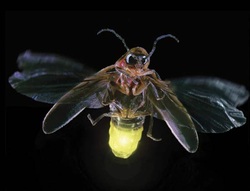What is bioluminescence?

Bioluminescence is the conversion of chemical energy to light in living organisms. Some thirty different bioluminescent systems exist in the world today, but all involve exergonic reactions of molecular oxygen with different substrates. These substrates are called luciferins, and they react with specialized enzymes called luciferases and oxygen to generate photons of visible light. All systems also involve a luciferase-bound peroxyluferin intermediate, the breakdown of which provides the energy required to excite molecules and generate light.
Several factors determine the color of the light emissions, including the amino acid sequence of the luciferase and the presence of accessory proteins. Bioluminescent systems also emit light differently. Some organisms such as certain bacteria emit light continuously, while others such as fireflies emit light in flashes.
The general process of bioluminescence is as follows:
Luciferin + luciferase + O₂→intermediates→excited molecule→non-excited molecule
The general process of bioluminescence is as follows:
Luciferin + luciferase + O₂→intermediates→excited molecule→non-excited molecule
Human Applications:
Bioluminescent proteins have a wide range of applications in the human world. For instance, Green Florescent Protein (GFP), originating from the crystal jelly or Aequoria Victoria, is used to study cellular processes such as gene expression and protein localization. The bioluminescent protein is used as a gene marker to identify areas of interest on DNA. Other possible uses of bioluminescence include Earth-friendly street lights in the form of glowing trees, and glow-in-the-dark landing zones for military helicopters and planes. Another application involves testing the amount of ATP in cells. For example, chemicals from fireflies may be injected into cells and the chemical changes a cell may experience can help scientists discover diseased cells such as muscular dystrophy and cancer. Lastly, chemicals from fireflies may be used for electronic detectors built into spacecrafts to detect life in outer space.
Bioluminescent proteins have a wide range of applications in the human world. For instance, Green Florescent Protein (GFP), originating from the crystal jelly or Aequoria Victoria, is used to study cellular processes such as gene expression and protein localization. The bioluminescent protein is used as a gene marker to identify areas of interest on DNA. Other possible uses of bioluminescence include Earth-friendly street lights in the form of glowing trees, and glow-in-the-dark landing zones for military helicopters and planes. Another application involves testing the amount of ATP in cells. For example, chemicals from fireflies may be injected into cells and the chemical changes a cell may experience can help scientists discover diseased cells such as muscular dystrophy and cancer. Lastly, chemicals from fireflies may be used for electronic detectors built into spacecrafts to detect life in outer space.
